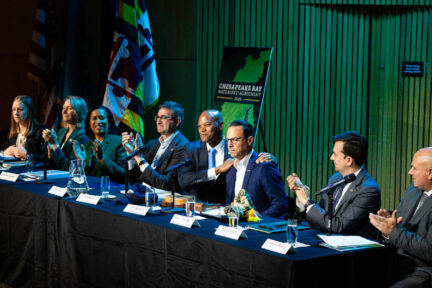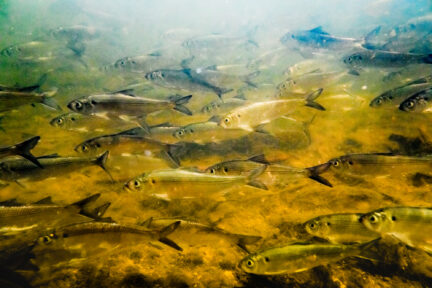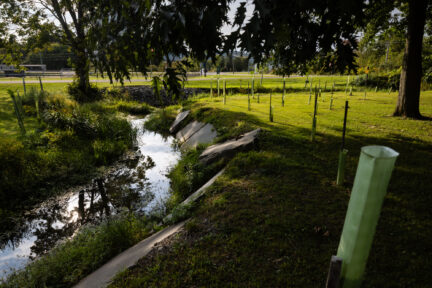More Than $9.2 Million in Grant Money Will Support Cleaner Local Waters Across the Chesapeake Bay
More Than $9.2 Million in Grant Money Will Support Cleaner Local Waters Across the Chesapeake Bay
This morning, the Chesapeake Bay Program and the National Fish and Wildlife Foundation (NFWF) announced the recipients of $9.2 million in grants for restoration and outreach initiatives in the Chesapeake Bay Watershed’s six states and the District of Columbia. This year’s 40 projects will use both innovative and well-known ways to create cleaner waters, restore habitat and strengthen iconic species such as brook trout and oysters, and engage homeowners and residents in environmental work supporting their community’s quality of life.
The funding for these environmental initiatives was awarded through the Chesapeake Bay Stewardship Fund via the Small Watershed Grants Program and the Chesapeake Bay Innovative Nutrient and Sediment Reduction Grants Program, both of which are administered by NFWF. Officials and guests announced the awards at the waterfront center of the Earth Conservation Corps at Diamond Teague Park in Washington, D.C., the site of a wetland funded by NFWF in 2012 and subsequently restored by ECC youth volunteers.
“Through the Chesapeake Bay Stewardship Fund, NFWF and our partners are making important investments across the Bay watershed that restore water quality, benefit fish and wildlife habitat, and strengthen local communities,” said David O’Neill, Vice President for Conservation Programs at NFWF. “This innovative public-private partnership, supported by the Environmental Protection Agency, and other federal agencies including the Natural Resources Conservation Service and the U.S. Forest Service, and private companies including Altria, Shell, CSX, Wal-Mart, and FedEx continues to provide a critical local funding source for conservation that maximizes outcomes for Bay restoration.”
The Innovative Nutrient and Sediment Reduction Grants Program (INSR), funded by the Environmental Protection Agency (EPA), awarded $6.6 million to 20 projects in the Chesapeake Bay watershed with recipients providing more than $14 million in matching funds. The INSR Program provides grants to innovative and cost-effective projects that dramatically reduce or eliminate the flow of nitrogen, phosphorus and sediment pollution into local waterways and the Chesapeake Bay. This year, many awardees’ projects show creative, collaborative partnerships that will engage everyone – local government, businesses and citizens – in better approaches for managing runoff from urban, suburban and agricultural lands.
“We’re proud to support these projects because they work. They are community driven and they are great example of people coming together to restore a national treasure like the Chesapeake Bay,” said EPA Administrator Gina McCarthy. “Investing in our regional watersheds, along with initiatives in green infrastructure and green jobs, are keys to a healthy environment, resilient communities, and a thriving economy.”
The Small Watershed Grants (SWG) Program, funded by a combination of public agencies and private support, awarded $2.6 million to 20 projects in the Chesapeake Bay Watershed with recipients providing $2.2 million in matching funds. The SWG program provides grants to organizations and municipal governments that are working to improve the condition of their local watershed through on-the-ground restoration, habitat conservation and community engagement. Many grant recipients expect to reduce pollution not only through infrastructures such as greener landscapes but through community outreach initiatives to promote sustainable landscaping and improved practices for managing runoff.
“New science is helping us focus work in areas where we will generate larger benefits with our conservation investment, which is particularly important in the Chesapeake Bay region” NRCS Chief Jason Weller said. “The National Fish and Wildlife Foundation and other partners are crucial to putting conservation practices on the ground, leading to cleaner water and air, healthier soil and stronger rural communities. We’re grateful for our strong partnership with NFWF and all of their hard work to accelerate conservation on private lands.”
Examples of this year’s Chesapeake Stewardship Fund grant recipients in the DC metro region include:
- Low Impact Development Center, Inc. ($249,873) will work with 8 to 10 communities in Prince George's County in the Anacostia and urban watersheds as a liaison with Prince George's Department of Environmental Resources and the development community to implement superior water quality solutions that enhance the sustainability and economic viability of the community.
- Anacostia Watershed Society ($200,000) and its partners will work to restore more than 10 acres of tidal wetlands in the Anacostia River, improving flood control in the National Capital region and increasing areas for outdoor recreation.
- City of Greenbelt ($147,960) will build on existing partnerships to remove 17,000 square feet of asphalt from the city and install permeable, articulating concrete block. The project will serve as a model for future public parking lot retrofit projects.
Since 2006, the Innovative Nutrient and Sediment Reduction Grant Program has provided $40 million to 94 projects that reduce the amount of nitrogen, phosphorus, and sediment in the Chesapeake Bay Watershed. Since 1999, the Small Watershed Grants Program has provided more than $34.2 million to support 704 projects in the region and has further leveraged close to $115.1 million in local matching funds for a total conservation investment in on-the-ground restoration of over $189.3 million.
For more information about the Chesapeake Bay Small Watershed Grants Program and the Chesapeake Bay Innovative Nutrient and Sediment Reduction Grants Program, visit www.nfwf.org/chesapeake.



